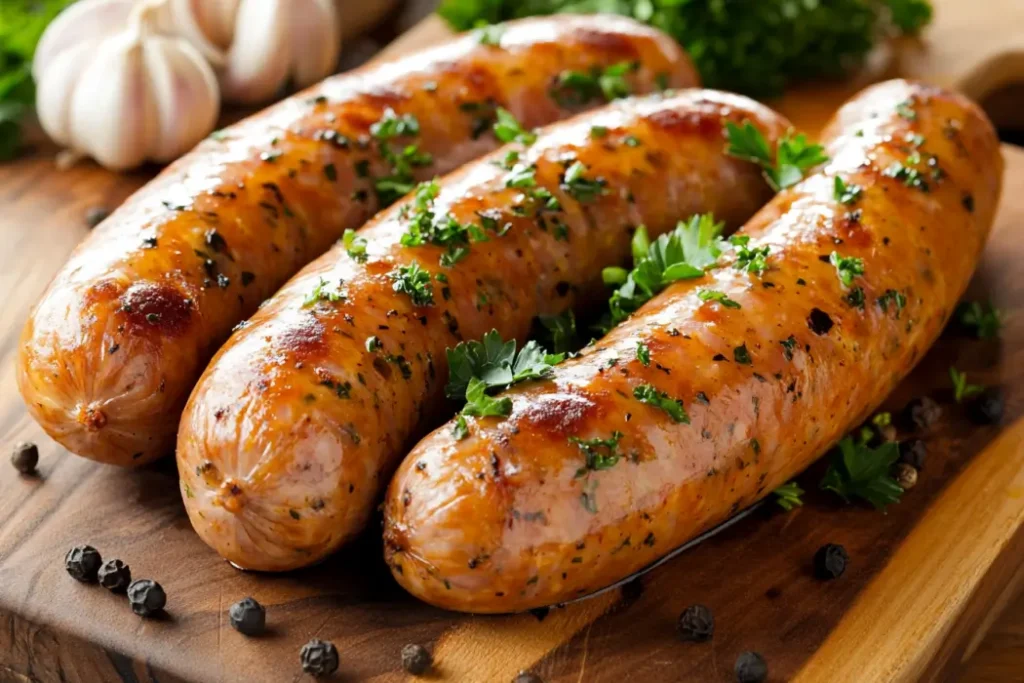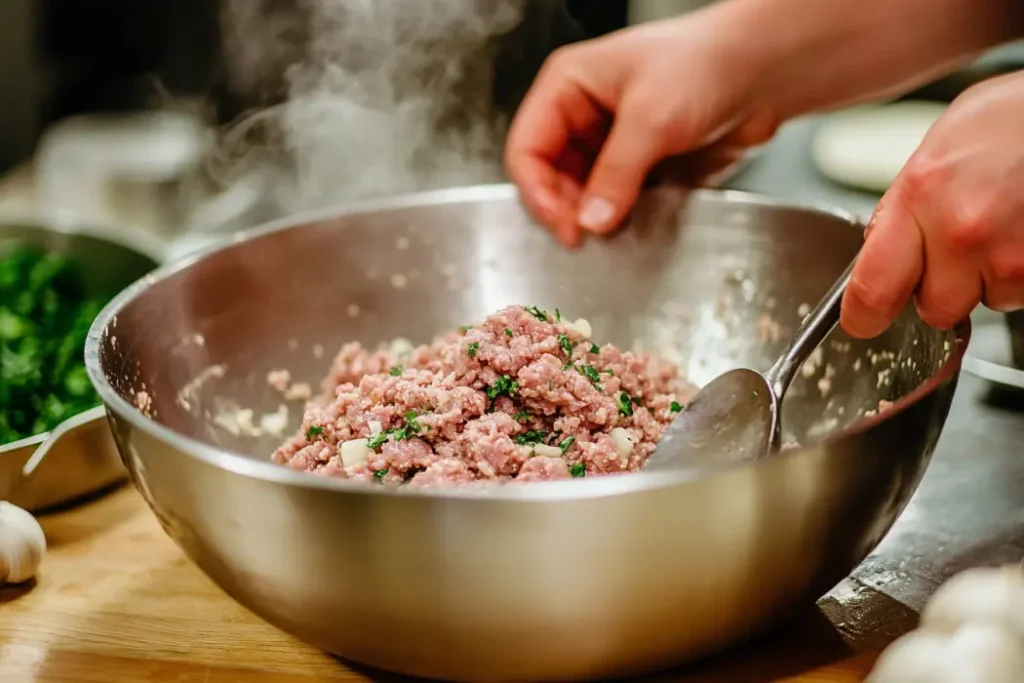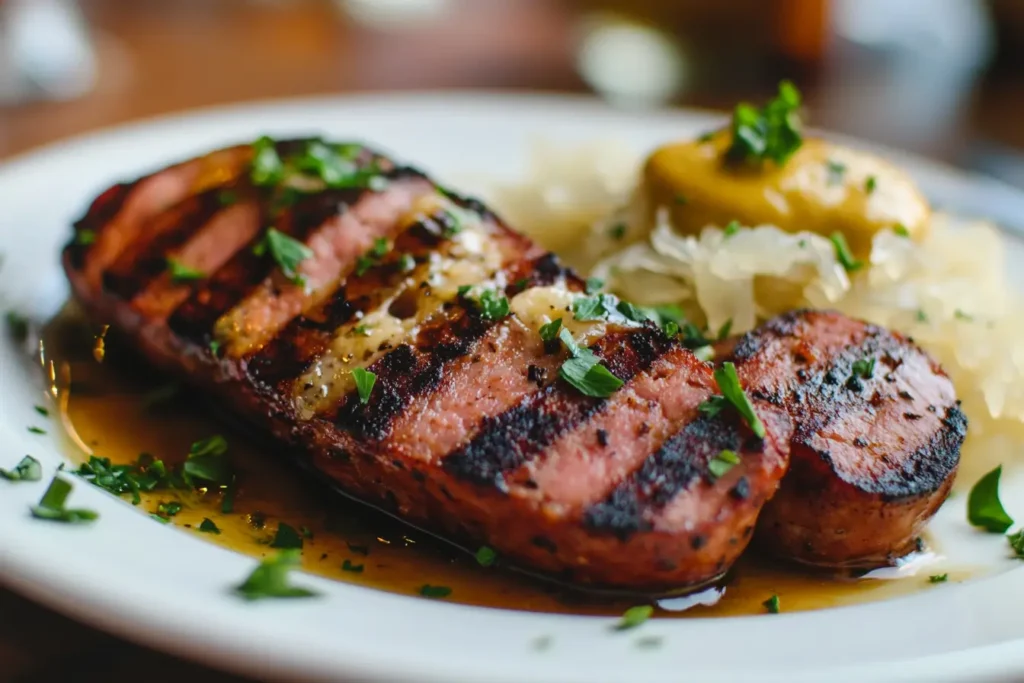
Have you ever heard of kielbasa? This popular sausage is a tasty treat with origins in Poland, but it’s loved by people all over the world. Kielbasa (pronounced keel-BAH-sah) is not just any sausage—it’s a flavorful, versatile food that has become a part of many family dinners and celebrations. Whether served grilled, fried, or added to hearty soups, kielbasa stands out for its rich taste and unique preparation process.
In this article, we’ll dive deep into the world of kielbasa to answer the question: How is kielbasa made? We’ll explore everything from the ingredients to the step-by-step process of creating this delicious sausage. By the end, you’ll know why kielbasa has been a staple in kitchens for centuries and how you can even try making it yourself.
The Basics of Kielbasa
To grasp the process of making kielbasa, it’s essential to know the key components involved. This sausage is generally made from ground meat, combined with a blend of spices and other tasty ingredients. While traditional recipes often rely on pork, variations can also feature beef, chicken, or turkey.
The meat is expertly seasoned with ingredients like garlic, marjoram, salt, and pepper, which create the distinctive taste that kielbasa is known for. Some regions and families add their own unique spices to create special variations of this beloved sausage.
After seasoning the meat, they stuff it into natural casings, usually made from cleaned animal intestines. These casings give kielbasa its iconic sausage shape. From there, they decide whether to cook or smoke the kielbasa, depending on the recipe.
Poland boasts many types of kielbasa, each with its own preparation methods and unique flavors. Some versions are smoked, adding a deep, rich taste, while others are fresh and require cooking. Regardless of the type, kielbasa remains a flavorful and versatile food enjoyed worldwide.
Step-by-Step Process
Crafting kielbasa involves multiple stages, each demanding attention to detail to ensure the ideal taste and consistency. Here’s an overview of the entire process from beginning to end
Preparing the Meat
The journey begins with choosing the right meat as the first step in making kielbasa. Traditionally, people use pork, but some recipes combine pork and beef or even include turkey for a leaner option. Chefs prioritize fresh, high-quality meat to ensure the best flavor for the sausage.
Once selected, they clean and trim the meat, removing excess fat, bones, and sinew. However, they intentionally leave a small amount of fat to add juiciness and flavor to the sausage. After cleaning, they cut the meat into small chunks to make grinding easier.
Next, they grind the meat to create a fine, uniform texture. Depending on the type of kielbasa, some recipes require grinding the meat more than once to achieve the desired consistency. This ground meat forms the base for the sausage, ready to absorb the seasonings in the next step.
Adding Seasonings
Next comes the seasoning stage, where the magic happens! Traditional kielbasa recipes include ingredients like garlic, marjoram, salt, and black pepper. These spices are carefully measured and mixed into the ground meat.
The seasonings are what give kielbasa its signature flavor. In some regions, additional ingredients like paprika or allspice may be added for a unique twist. Once the spices are mixed in, the meat is kneaded thoroughly to ensure that the flavors are evenly distributed.
In some cases, a small amount of water or broth is added to the mixture. This helps to keep the meat moist and makes it easier to stuff into casings later on.
Stuffing the Sausage
After seasoning the meat, the next step involves stuffing it into sausage casings. Traditionally, cooks use natural casings made from cleaned animal intestines. They soak and rinse the casings to make them pliable and ready for use.
Using a sausage stuffer, they carefully fill the casings with the seasoned meat mixture. They work slowly to avoid air pockets, which can cause the sausage to burst during cooking. Once filled, they twist or tie the casings at regular intervals to create individual links of kielbasa.
Precision matters in this step. Overfilling the casing can make it too tight and prone to splitting, while underfilling may cause the sausage to lose its shape. Once the links are tied, the kielbasa is ready for the next stage: smoking or cooking.
This process requires skill and attention to detail, ensuring that each sausage maintains its shape and holds its flavorful filling. Properly stuffed sausages deliver the satisfying texture and taste that make kielbasa so popular.

Smoking or Cooking
After stuffing the sausages, cooks choose between two main methods to prepare kielbasa: smoking or cooking.
- Smoking: Many people prefer to smoke kielbasa to give it a rich, smoky flavor. Cooks hang the sausages in a smoker or smokehouse, where they expose them to low, steady heat and aromatic wood smoke. This process can last several hours and also preserves the sausages. Smoked kielbasa comes out fully cooked and ready to eat.
- Cooking: For fresh kielbasa, cooks boil, bake, or grill it to bring out its flavors. Boiling ensures that the sausage stays moist and tender, while grilling or baking adds a slightly crispy exterior. Unlike smoked kielbasa, fresh varieties need cooking before they can be enjoyed.
Both methods create delicious results, but each suits different tastes and occasions. Smokers infuse kielbasa with deep, rich flavors, while cooking highlights its natural juiciness and spices. Regardless of the method, cooks always aim to create a sausage that is flavorful and satisfying.
Types of Kielbasa Around the World
Kielbasa is more than just one type of sausage—it comes in many varieties, each with its own unique flavor, texture, and preparation method. While it originates from Poland, its popularity has spread worldwide, with each region adding its own twist. Let’s explore the different types of kielbasa and how they vary across regions.
Polish Kielbasa Varieties
Poland boasts several traditional types of kielbasa, each bringing unique flavors and textures to the table. Below are some of the most popular varieties:
- Kiełbasa Wiejska (Country Sausage): People recognize this type as one of the most famous. It combines pork and veal, seasoned with garlic and marjoram, and usually undergoes smoking to enhance its flavor.
- Kiełbasa Krakowska (Krakow Sausage): This firm and dry sausage features lean pork as its primary ingredient. Cooks often season it with garlic and pepper, slice it, and serve it cold.
- Kiełbasa Biała (White Sausage): This fresh variety skips smoking and cooking. Instead, chefs boil it or add it to soups like Żurek (Polish sour rye soup) to enhance its flavor.
- Kiełbasa Czosnkowa (Garlic Sausage): True to its name, this sausage bursts with garlic flavor. Producers typically smoke it to achieve its savory, deep taste.
Polish chefs and families prepare each type of kielbasa with care, tailoring the recipe to fit the specific occasion. Some varieties excel when grilled or fried, while others shine in soups or cold platters. These carefully crafted sausages reflect the artistry and tradition of Polish cuisine.
American Kielbasa
When Polish immigrants brought kielbasa to the United States, it quickly became a favorite among Americans. American kielbasa is often made with pork or a combination of pork and beef, and it’s typically smoked.
The American version is slightly sweeter and less heavily spiced than traditional Polish kielbasa, making it a versatile ingredient for dishes like jambalaya, casseroles, and breakfast hash. It’s also a popular choice for grilling, especially during summer cookouts.
Kielbasa in Other Countries
Beyond Poland and the United States, kielbasa-inspired sausages can be found in other parts of the world:
- Germany: While not called kielbasa, German sausages like bratwurst and knackwurst share similarities in terms of preparation and ingredients.
- Ukraine: The Ukrainian version, kovbasa, is often seasoned with garlic, black pepper, and coriander. It’s a close cousin of Polish kielbasa and is enjoyed in similar ways.
- Lithuania: Skilandis, a smoked sausage from Lithuania, is similar to kielbasa and often made with pork and flavored with caraway seeds.
These regional variations showcase the versatility of sausage-making traditions and how kielbasa’s basic principles have been adapted worldwide.
Fresh vs. Smoked Kielbasa
Kielbasa comes in two main varieties: fresh and smoked, and each offers a unique flavor and texture. Let’s explore the differences between the two.
Fresh Kielbasa
Cooks prepare fresh kielbasa using raw, uncooked sausage. Before serving, they boil, grill, bake, or fry it to perfection. Fresh kielbasa has a mild flavor, allowing the natural taste of the meat and spices to shine. Its tender, juicy texture makes it a favorite for soups, stews, or simple meals paired with potatoes and vegetables.
Smoked Kielbasa
Producers smoke kielbasa to cook it and infuse it with a rich, smoky flavor. During the process, they hang the sausages in a smokehouse, exposing them to aromatic wood smoke for several hours. This method not only enhances the taste but also extends the sausage’s shelf life. Smoked kielbasa is ready to eat once it comes out of the smoker, although many people prefer to grill or fry it for added flavor.
Both types of kielbasa deliver delicious results, but the choice depends on your preference and how you plan to use the sausage in a dish. Fresh kielbasa works well in hearty recipes, while smoked kielbasa stands out for its bold, savory taste.
Taste and Texture
One of the main reasons kielbasa is so popular is its incredible taste and texture. The combination of spices, juicy meat, and smoky flavor makes it irresistible to sausage lovers. The texture is firm yet tender, making it perfect for slicing, grilling, or adding to recipes.
Versatility in Cooking
Kielbasa is a versatile ingredient that works in countless dishes. It can be grilled and served with mustard, sliced and added to soups or stews, or even chopped into pasta dishes. Its ability to adapt to different cuisines has contributed to its widespread popularity.
What dishes pair best with kielbasa?
Kielbasa can be paired with a wide range of dishes, making it a favorite ingredient in many kitchens. Here are some popular options:
- Pierogi: These Polish dumplings, often filled with potatoes and cheese, make the perfect companion for kielbasa.
- Cabbage Dishes: Kielbasa pairs wonderfully with sautéed cabbage or stuffed cabbage rolls.
- Soups and Stews: Kielbasa adds flavor and protein to hearty dishes like Polish Żurek (sour rye soup) or kapuśniak (cabbage soup).
- Grilled Vegetables: A simple side of roasted or grilled vegetables brings out the smoky flavor of kielbasa.
- Breakfast Skillets: Add kielbasa to scrambled eggs, potatoes, and cheese for a delicious breakfast or brunch.
The versatility of kielbasa means you can enjoy it in almost any meal, from traditional Polish dishes to modern favorites.

FAQ
Can Kielbasa Be Made at Home?
Yes, making kielbasa at home is completely possible! With the right tools—such as a meat grinder and sausage stuffer—you can follow traditional recipes to create your own kielbasa. Homemade kielbasa allows you to control the ingredients and seasonings, ensuring it matches your flavor preferences. It’s also a fun way to experiment with cooking and explore Polish cuisine.
For meal ideas, check out our guide on What Goes Well with Kielbasa for Dinner?.
How Long Does It Take to Make Kielbasa?
The time varies depending on the type of kielbasa you’re making. Fresh kielbasa can be prepared and cooked in a few hours, while smoked kielbasa takes longer since the smoking process can take up to 8 hours. Including preparation, seasoning, and stuffing, the overall process may take between 3 and 10 hours, depending on experience and the method chosen.
For recipe ideas, explore our collection of Kielbasa and Pasta Recipes – Irresistible Dinner Ideas.
Is Kielbasa Healthy?
Kielbasa can be part of a balanced diet when eaten in moderation. It’s high in protein and contains vitamins and minerals like iron and zinc. However, it’s also high in sodium and fat, especially smoked varieties. Opt for leaner versions like turkey or chicken kielbasa if you’re looking for healthier alternatives, and pair it with vegetables and whole grains for a balanced meal.
How Is Kielbasa Different From Other Sausages?
Kielbasa stands out due to its unique flavor, shape, and preparation. It’s typically seasoned with garlic and marjoram, giving it a distinct taste. Unlike many sausages, kielbasa is often smoked for a rich flavor and formed into long, U-shaped links. Its connection to Polish heritage also makes it a cultural staple, unlike general-purpose sausages.
Want to dive deeper? Read What’s the Difference Between Kielbasa and Other Sausag
Conclusion
Kielbasa is so much more than just a sausage—it’s a cultural icon, a family tradition, and a delicious treat enjoyed by people around the world. From its roots in Poland to its global popularity, kielbasa has earned its place as a beloved staple of traditional and modern cuisine.
We’ve explored the step-by-step process of how kielbasa is made, from selecting the perfect meat to seasoning it with spices, stuffing it into casings, and cooking it to perfection. We’ve also learned about the different types of kielbasa, from smoked varieties to fresh versions, and how each brings its own unique flavor to the table.
Kielbasa’s versatility in cooking is another reason for its enduring popularity. Whether you’re enjoying it in a hearty soup, grilling it at a barbecue, or using it as the star ingredient in a creative fusion dish, kielbasa never fails to deliver on taste and satisfaction. It’s a food that connects people across cultures and generations, reminding us of the joy of sharing meals with loved ones.
